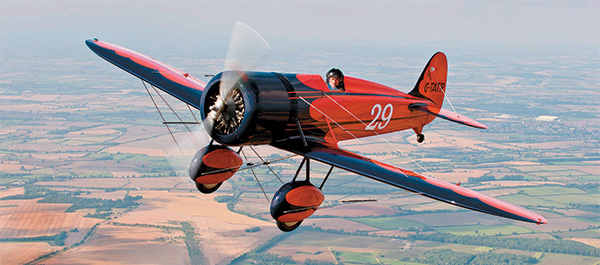
Though the beer-keg Gee Bees would get most of the attention once the Thompson Trophy races began, the Travel Air Type R, popularly known as the “Mystery Ship” and often given the misnomer Mystery S, was the first civilian air racer to beat military-backed modified fighters. In 1929 the monoplane Mystery Ship won a 50-mile pylon race at the Cleveland National Air Races against a field that included U.S. Army Air Corps and Navy Curtiss biplanes. While war-surplus fighters flown by civilians would monopolize Thompson Trophy racing from 1946 through ’49, it was the end of official military dominance of air racing. (Government-backed 1929 and 1931 Schneider Trophy racers were not military machines.) Some continue to credit the Mystery Ship with winning the first Thompson Trophy race, but the 1929 event was for the more modest Thompson Cup. The towering Thompson Trophy and its 100-mile unlimited pylon races weren’t created until 1930.
British vintage-airplane collector Richard Seeley understands the importance of the Type R—it was dubbed Mystery Ship by the press because Travel Air wouldn’t reveal or talk about it during construction—and in 2008 Seeley contracted with the small restoration and replication shop Aero Antiques, in Southampton, England, to build him what he considers to be the seventh “continuation” Type R, a near-exact version of the 1929 Thompson Cup winner. Travel Air built five, and in the late 1970s American Jim Younkin built a sixth close replica that is still flying.
Seeley’s new Travel Air carries a 9-cylinder, 300-hp Lycoming R-680 in place of the original’s 400-hp Wright Whirlwind J-6. He also had disc brakes and a steerable tailwheel added for use on paved runways and narrow taxiways, since the original airplane relied solely on a fixed tailskid digging into grass for braking, and rudder deflection for steering. Seeley’s project occupied Aero Antiques owner Ron Souch and his staff full time for four years.
The building process relied upon drawings made from dim memory back in the 1970s for Younkin by the airplane’s designer, Herb Rawdon (the R in Type R, some say), plus some careful measurements that Seeley made of a fully restored Type R once owned by California hellraiser Pancho Barnes. Neither the name of its owner nor the location where it is stored somewhere in England are publicly known. Now that’s a mystery ship.




